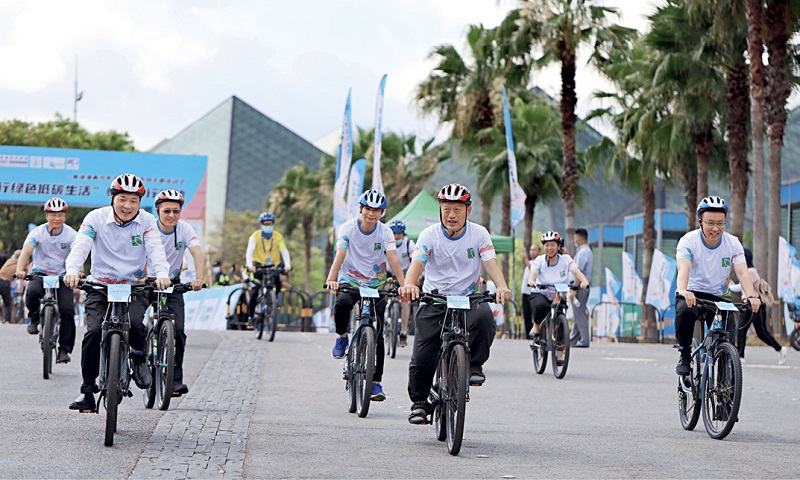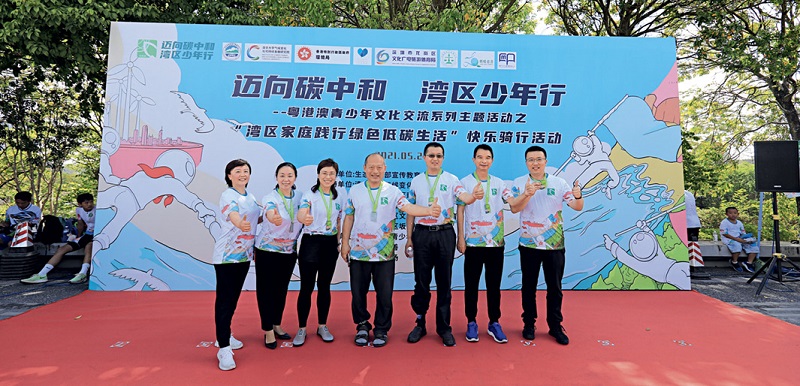Jia Feng, former director and current chief expert of the Publicity and Education Center of the Ministry of Ecology and Environment, has been engaged in ecological and environmental protection work for over three decades. His work includes supporting the building of an ecological civilization in China, environmental education and climate communication. An adjunct professor of the College of Environmental Sciences and Engineering at Peking University, Jia also gives lectures and makes documentaries, advocating a green lifestyle.
Therefore, when China celebrated the 50th anniversary of the inclusion of ecological and environmental protection in the government agenda on June 5, 2023, which happened to be the World Environment Day, he was one of the most authoritative voices to explain China’s work in this sphere.
Jia regards the 18th National Congress of the Communist Party of China (CPC) in 2012 as a new beginning of China’s environmental protection endeavor. “Since then, China has given top priority to ecological protection amid development, promoting green transition along with economic and social progress,” he told China Today. “The country has been advancing modernization featuring harmonious coexistence between humans and nature, creating a miracle of green development that has awed the world and enabled the people to benefit from more inclusive and sustainable growth.”

Jia Feng rides a bicycle together with other participants of the cycling activity held in Shenzhen, on May 22, 2021.
How It Started
Since the Chinese government proposed the idea of ecological and environmental protection half a century ago, resource conservation and environmental protection became a basic national policy and sustainable development a national strategy. The 18th National Congress of the CPC convened in 2012 proposed a “five-sphere integrated plan” – covering economic, political, cultural and social development and also, for the first time, ecological development. It was the overall plan for developing socialism with Chinese characteristics and building a “beautiful China.”
President Xi Jinping articulated the importance of building an ecological civilization further in his address at the national conference on ecological and environmental protection in 2018. “When ecology prospers, civilization prospers; when ecology decays, civilization decays.”
Jia said China’s ecological and environmental protection has seen historic, transformative, and comprehensive changes. Since 2012, China has been pursuing environmental preservation following ambitious goals. Despite having no other successful experience to follow, the goals were advanced, sought to avoid the Western development path of “pollution before treatment.”
In the industrialization process of developed countries, economic growth was accompanied by environmental deterioration. There are many incidents of industrialization-related pollution endangering public health around the world, such as the “Great Smog of London” that covered the British capital for five days in 1952 and killed hundreds of people; photochemical pollution first identified in Los Angeles in 1944 arising from high traffic density and other factors; and the Minamata disease in Japan, mercury poisoning caused by eating tainted fish from the Minamata Bay.
Jia said developed countries’ failure to balance the relations between economic growth and environmental protection in the process of industrialization provides “painful lessons.”
While in China, the idea of green development was put forward and explained in 2005 by Xi Jinping, then Secretary of the CPC Zhejiang Provincial Committee, during his inspection tour of the county of Anji in Zhejiang. His comment that lucid waters and lush mountains are valuable assets embodied the philosophy of harmonious coexistence between human and nature.
The Blue Sky Action
Pollution remains an international concern. To combat it at home, the State Council, China’s cabinet, has issued five-year action plans for the prevention and control of air, water, and soil pollution. Each plan includes measures in 10 aspects. The air pollution combat plan released in 2013 laid down that by 2017, the concentration of fine particles in air measuring 2.5 microns – PM2.5 – should be decreased by about 25 percent in the Beijing-Tianjin-Hebei region, 20 percent in the Yangtze River Delta, and 15 percent in the Pearl River Delta. The average annual concentration of PM 2.5 in Beijing was to be controlled at around 60 micrograms per cubic meter.
Jia explained what led to these goals and their results. From 2012 to 2017, China’s annual GDP per capita increased from around US $4,000 to US $8,000. The country was still in the process of industrialization, a period when Western countries were emitting great volumes of pollutants, deteriorating existing environmental pollution issue. No country achieved synchronous improvement in the economy and environment during industrialization in the West. But China has been pursuing the goal and made remarkable achievements.
Jia had an anecdote about this, “From 2012 to 2015, Beijing residents often shared images of a blue sky and white clouds on social media; but today, very few do that as they have become accustomed to it.” It proves China’s achievements in winning the battle against air pollution. In 2018, the State Council issued the “Blue Sky” action plan. The goal was to reduce emissions further and slash the number of days with high pollution by taking actions across several sectors, including revamping industrial structures and boosting a green transport system.
Michael Greenstone, director of the Energy Policy Institute at the University of Chicago, acknowledged the results in his New York Times article “Four Years After Declaring War on Pollution, China is Winning.” “[Chinese] cities have cut concentrations of fine particulates in the air by 32 percent on average, in just four years,” he wrote. But it took about a dozen years for the United States to achieve the 32-percent reduction China has achieved in just four years, he noted. Between 2013 and 2020, Beijing cut air pollution by 35 percent, which meant the average lifespan of residents was extended by 3.3 years, according to a study of the Energy Policy Institute Greenstone works for.

Jia Feng (middle) takes part in the cycling activity of the Greater Bay Area Youth Cultural Exchanges with the theme “Towards Net Zero” at the Shenzhen Universiade Center in Longgang District, on May 22, 2021.
The Green Travel Choice
In recent years, Jia found that the environmental communication strategy needed to change. “We used to tell people what to do, but now we have changed to persuading people to follow what we do.”
In 2020, China promised to peak its carbon dioxide emissions by 2030 and achieve carbon neutrality by 2060. Consumer-based per-capita emissions account for a considerable proportion of the country’s total carbon emissions. Jia estimated per-capita carbon emissions are currently around eight to nine tons, more than 50 percent of which occur in the consumption sector. If this can be reduced, the pressure of carbon reduction on manufacturers will ease.
So, Jia started sharing his cycling stories on social media platforms, including Sina Weibo and WeChat Moments, to encourage people to embrace a green lifestyle. Some statistics from his bike trips: The distance to and from his workplace is around 15 kilometers. As there are about 250 working days in a year, he cycles approximately 4,000 kilometers. This means he achieves emission reduction of three kilograms by cycling every 10 kilometers, or 1.2 tons every year, reaching his goal of “one ton of carbon reduction per year by each bike rider.”
“By documenting my cycling trips, I hope to create a new way of spreading a green lifestyle via social media. Over three years, I have written over 370 Weibo posts about cycling, which were read by 11 million.” The feedback helps him to interact with netizens and improve his writing.
In 2021, officials in the Ministry of Ecology and Environment formed a cycling association and Jia was elected its president. He told his colleagues, “We are not just cycling enthusiasts, but also decision-makers. We should take the initiative to lead a green lifestyle among our family members and friends so that more people make green travel choices.”
However, this also depends on a city’s green infrastructure. In 2021, nearly 48 percent residents in downtown Beijing chose to travel by bike or in walk, an increase of 6.9 percent compared to 2017. Shared bicycles were used on 950 million occasions in the capital city in 2021. Data from a brand of shared bicycles indicated its users travelled 694 million kilometers in total by bike in the year, reducing carbon emissions by 27,500 tons.
During the COVID-19 pandemic, while many shops closed, some bike stores in Beijing saw robust business growth. According to Jia, this reflects that more Chinese people are adopting a green lifestyle.
He said that the Chinese ecological civilization is not only about protecting the environment and controlling pollution, or embracing a bluer sky and greener water. There is potential for higher quality development in people’s everyday life. The 20th National Congress of the CPC last year set the overall goals for China’s development by 2035, which include “establishing eco-friendly ways of work and life; steadily lowering carbon emissions after peaking; fundamentally improving the environment; and largely accomplishing the goal of building a Beautiful China.”
A significant number of people will participate in the green transformation, which will give rise to various new business models in the future. “A good ecological environment is the most equitable public good, and our work is particularly meaningful for this reason,” Jia concluded.